Energy Storage Science and Technology ›› 2024, Vol. 13 ›› Issue (7): 2470-2482.doi: 10.19799/j.cnki.2095-4239.2024.0091
• Energy Storage Test: Methods and Evaluation • Previous Articles Next Articles
Guohe CHEN1,2( ), Peizhao LYU1,2, Menghan LI1,2, Zhonghao RAO1,2(
), Peizhao LYU1,2, Menghan LI1,2, Zhonghao RAO1,2( )
)
Received:2024-01-28
Revised:2024-02-08
Online:2024-07-28
Published:2024-07-23
Contact:
Zhonghao RAO
E-mail:202121301006@stu.hebut.edu.cn;raozhonghao@hebut.edu.cn
CLC Number:
Guohe CHEN, Peizhao LYU, Menghan LI, Zhonghao RAO. Research progress on thermal runaway propagation characteristics of lithium-ion batteries and its inhibiting strategies[J]. Energy Storage Science and Technology, 2024, 13(7): 2470-2482.
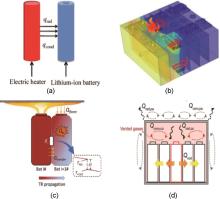
Fig. 1
Thermal runaway propagation paths. (a) 2 mm spacing, Heat transfer paths for heater-induced battery thermal runaway[11]; (b) Heat transfer path of a series-connected square battery module[12]; (c) Heat transfer paths in a top plate in a semi-enclosed space[14]; (d) Heat transfer paths in an enclosed space[15]"

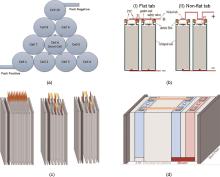
Fig. 3
Battery connection method (a) Comparison of 10S1P and 1P10S for cylindrical batteries [21]; (b) Two types of connecting tabs in cylindrical batteries [22]; (c) Comparison of three sets of experiments with open circuit, 3P4S and 4P3S [23]; (b) Effect of parallel connection on thermal runaway[25]"

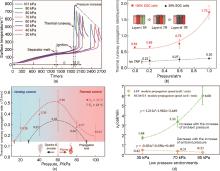
Fig. 5
Environmental factors (a) Effect of ambient pressure on the surface temperature of the battery cells; (b) thermal runaway propagation rate of the battery under open circuit; (c) thermal runaway propagation rate of the battery under parallel connection; (d) thermal runaway propagation rate of LFP and NCM523"

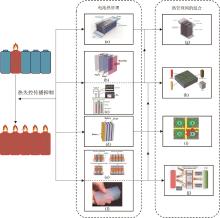
Fig. 6
Thermal management to suppress thermal runaway propagation (a) air cooling[35]; (b) liquid-cooled plate cooling [36]; (c) immersion cooling [37]; (d) phase change material [38]; (e) high thermal conductivity material [39]; (f) aerogel insulation[40]; (g) Combination of air-cooled and submerged liquid-cooled[42]; (h) combination between the phase change material, the aerogel and the liquid-cooled plate [41]; (i) combination of the phase change material and the aerogel [42]; (j) combination of the high thermal conductivity material and the aerogel combinations 43]"

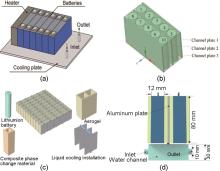
Fig. 8
Combination of cold plate and other thermal management technology (a) Combination of aerogel and liquid-cooled plate[73]; (b) Combination of PCM and liquid-cooled plate[74]; (c) Combinations between PCM, aerogels and liquid-cooled plates; (d) Combination of PCM,aluminium plate and liquid cooling[76]"

| 1 | HAOYANG W, LEI G, YING J. The predicament of clean energy technology promotion in China in the carbon neutrality context: Lessons from China's environmental regulation policies from the perspective of the evolutionary game theory [J]. Energy Reports, 2022, 8: 4706-4723. |
| 2 | KORKUT P U, EMRE C A, TEVFIK K M, et al. Evaluation of the role of clean energy technologies, human capital, urbanization, and income on the environmental quality in the United States[J]. Journal of Cleaner Production, 2023, 402: doi: 10.1016/j.jclepro.136802. |
| 3 | LIU J L, DUAN Q L, MA M N, et al. Aging mechanisms and thermal stability of aged commercial 18650 lithium ion battery induced by slight overcharging cycling[J]. Journal of Power Sources, 2020, 445: doi: 10.1016/j.jpowsour.2019.227263. |
| 4 | ZHANG G, WEI X, CHEN S, et al. Research on the impact of high-temperature aging on the thermal safety of lithium-ion batteries[J]. Journal of Energy Chemistry, 2023, 87: 378-389. |
| 5 | HENRIKSEN M, VAAGSAETHER K, LUNDBERG J, et al. Explosion characteristics for Li-ion battery electrolytes at elevated temperatures[J]. Journal of Hazardous Materials, 2019, 371: 1-7. |
| 6 | HUANG Z, LIU J, ZHAI H, et al. Experimental investigation on the characteristics of thermal runaway and its propagation of large-format lithium ion batteries under overcharging and overheating conditions [J]. Energy, 2021, 233: doi: 10.1016/j.energy.2021.121103. |
| 7 | YU S Y, MAO Y, XIE J Y, et al. Thermal runaway chain reaction determination and mechanism model establishment of NCA-graphite battery based on the internal temperature[J]. Applied Energy, 2024, 353: doi: 10.1016/j.apenergy.2024.122097. |
| 8 | LI Y, LIU X, WANG L, et al. Thermal runaway mechanism of lithium-ion battery with LiNi0.8Mn0.1Co0.1O2 cathode materials [J]. Nano Energy, 2021, 85: doi: 10.1002/adma.202107326. |
| 9 | ZHANG Y J, WANG H W, LI W F, et al. Size distribution and elemental composition of vent particles from abused prismatic Ni-rich automotive lithium-ion batteries[J]. Journal of Energy Storage, 2019, 26: doi: 10.1016/j.est.2019.100991. |
| 10 | SONG L F, HUANG Z H, MEI W, et al. Thermal runaway propagation behavior and energy flow distribution analysis of 280 Ah LiFePO4 battery[J]. Process Safety and Environmental Protection, 2023, 170: 1066-1078. |
| 11 | LI H, CHEN H D, ZHONG G B, et al. Experimental study on thermal runaway risk of 18650 lithium ion battery under side-heating condition[J]. Journal of Loss Prevention in the Process Industries, 2019, 61: 122-129. |
| 12 | FENG X N, SUN J, OUYANG M G, et al. Characterization of penetration induced thermal runaway propagation process within a large format lithium ion battery module[J]. Journal of Power Sources, 2015, 275: 261-273. |
| 13 | LI K J, XU C S, WANG H B, et al. Investigation for the effect of side plates on thermal runaway propagation characteristics in battery modules[J]. Applied Thermal Engineering, doi: 10.1016/j.applthermaleng. 2022.201.117774. |
| 14 | ZHANG Y, ZHAO H L, WANG G Q, et al. Effect of flame heating on thermal runaway propagation of lithium-ion batteries in confined space[J]. Journal of Energy Storage, 2024, 78: doi:10.1016/j.est.2024.110052. |
| 15 | WANG G Q, PING P, ZHANG Y, et al. Modeling thermal runaway propagation of lithium-ion batteries under impacts of ceiling jet fire[J]. Process Safety and Environmental Protection, 2023, 175: 524-540. |
| 16 | JIN C, SUN Y, WANG H, et al. Heating power and heating energy effect on the thermal runaway propagation characteristics of lithium-ion battery module: Experiments and modeling[J]. Applied Energy, 2022, 312: doi: 10.1016/j.apenergy.2022.118760. |
| 17 | LAI X, WANG S Y, WANG H B, et al. Investigation of thermal runaway propagation characteristics of lithium-ion battery modules under different trigger modes[J]. International Journal of Heat and Mass Transfer, 2021, 171: 15. |
| 18 | SCHÖBERL J, ANK M, SCHREIBER M, et al. Thermal runaway propagation in automotive lithium-ion batteries with NMC-811 and LFP cathodes: Safety requirements and impact on system integration[J]. eTransportation, 2024, 19: doi.org/10.14459/2023mp1717758. |
| 19 | HU J, LIU T, TANG Q Y, et al. Experimental investigation on thermal runaway propagation in the lithium ion battery modules under charging condition[J]. Applied Thermal Engineering, doi: 10.1016/j.applthermaleng. 2022. 211.118522. |
| 20 | ZHU M, ZHANG S, CHEN Y, et al. Experimental and analytical investigation on the thermal runaway propagation characteristics of lithium-ion battery module with NCM pouch cells under various state of charge and spacing[J]. Journal of Energy Storage, 2023, doi:10.1016/j.est.2023.108380. |
| 21 | LAMB J, ORENDORFF C, STEELE L, et al. Failure propagation in multi-cell lithium ion batteries[J]. Journal of Power Sources, 2015, 283: 517-523. |
| 22 | NIU H C, CHEN C X, JI D, et al. Thermal-runaway propagation over a linear cylindrical battery module[J]. Fire Technology, 2020, 56(6): 2491-2507. |
| 23 | XU C S, ZHANG F S, FENG X N, et al. Experimental study on thermal runaway propagation of lithium-ion battery modules with different parallel-series hybrid connections[J]. Journal of Cleaner Production, 2021, 284: doi: 10.1016/j.jclepro.124749. |
| 24 | HUANG Z H, ZHAO C P, LI H, ET al. Experimental study on thermal runaway and its propagation in the large format lithium ion battery module with two electrical connection modes[J]. Energy, 2020, 205: 16. |
| 25 | ZHOU Z, LI M, ZHOU X, et al. Investigating thermal runaway characteristics and trigger mechanism of the parallel lithium-ion battery [J]. Applied Energy, 2023, 349: doi: 10.1016/j.apenergy.2023.121690. |
| 26 | FANG J, CAI J, HE X. Experimental study on the vertical thermal runaway propagation in cylindrical Lithium-ion batteries: Effects of spacing and state of charge [J]. Applied Thermal Engineering, 2021, 197: doi: 10.1016/j.energy.2020.117906. |
| 27 | ZHOU Z Z, ZHOU X D, JU X Y, et al. Experimental study of thermal runaway propagation along horizontal and vertical directions for LiFePO4 electrical energy storage modules [J]. Renewable Energy, 2023, 207: 13-26. |
| 28 | WANG H, WANG Q, ZHAO Z, et al. Thermal runaway propagation behavior of the Cell-to-Pack battery system [J]. Journal of Energy Chemistry, 2023, 84: 162-172. |
| 29 | JIN C, SUN Y, YAO J, et al. No thermal runaway propagation optimization design of battery arrangement for cell-to-chassis technology [J]. eTransportation, 2022, 14: 100199. |
| 30 | FU Y Y, LU S, SHI L, et al. Ignition and combustion characteristics of lithium ion batteries under low atmospheric pressure[J]. Energy, 2018, 161: 38-45. |
| 31 | LIU Y, NIU H, XU C, et al. Thermal runaway propagation in linear battery module under low atmospheric pressure [J]. Applied Thermal Engineering, 2022, 216: 119086. |
| 32 | LIU Y, NIU H, LIU J, et al. Layer-to-layer thermal runaway propagation of open-circuit cylindrical li-ion batteries: Effect of ambient pressure [J]. Journal of Energy Storage, 2022, 55: doi:10.1016/j.est.2022.105709. |
| 33 | JIA Z Z, HUANG Z H, ZHAI H J, et al. Experimental investigation on thermal runaway propagation of 18650 lithium-ion battery modules with two cathode materials at low pressure[J]. Energy, 2022, 251: doi: 10.1016/j.energy.2022.123925. |
| 34 | E J, YUE M, CHEN J, et al. Effects of the different air cooling strategies on cooling performance of a lithium-ion battery module with baffle [J]. Applied Thermal Engineering, 2018, 144: 231-241. |
| 35 | LI M, MA S, JIN H, et al. Performance analysis of liquid cooling battery thermal management system in different cooling cases[J]. Journal of Energy Storage, 2023, 72: doi:10.1016/j.est.2023.108651. |
| 36 | WANG G, KONG D, PING P, et al. Modeling venting behavior of lithium-ion batteries during thermal runaway propagation by coupling CFD and thermal resistance network [J]. Applied Energy, 2023, 334: doi: 10.1016/j.apenergy.2023.120660. |
| 37 | FU H, WANG J, LI L, et al. Numerical study of mini-channel liquid cooling for suppressing thermal runaway propagation in a lithium-ion battery pack [J]. Applied Thermal Engineering, 2023, 234: doi: 10.1016/j.energy.2023.121349. |
| 38 | LI X T, ZHOU Z Y, ZHANG M J, et al. A liquid cooling technology based on fluorocarbons for lithium-ion battery thermal safety[J]. Journal of Loss Prevention in the Process Industries, 2022, 78: doi: 10.1016/j.jlp.2022.104818. |
| 39 | LUO W Y, ZHAO L Y, CHEN M Y. The effect of PCM on mitigating thermal runaway propagation in lithium-ion battery modules[J]. Applied Thermal Engineering, 2024, 236: 121608. |
| 40 | JINYONG K, YANG C B, JOSHUA L, et al. A comprehensive numerical and experimental study for the passive thermal management in battery modules and packs[J]. Journal of the Electrochemical Society, 2022, 169(11): 110543. |
| 41 | KHAMIDI M, GLOVER C, FARHAN S A, et al. Effect of silica aerogel on the thermal conductivity of cement paste for the construction of concrete buildings in sustainable cities[Z]. WIT Transactions on the Built Environment, 2014, 137: 665-674. |
| 42 | MAHESH S P, JAE-HYEONG S, MOO-YEON L. A novel dielectric fluid immersion cooling technology for Li-ion battery thermal management[J]. Energy Conversion and Management, 2021, 229: doi: 10.1016/j.enconman.2020.113715. |
| 43 | OUYANG T, LIU B, XU P, et al. Electrochemical-thermal coupled modelling and multi-measure prevention strategy for Li-ion battery thermal runaway [J]. International Journal of Heat and Mass Transfer, 2022, 194: doi: 10.1016/j.ijheatmasstransfer. 2022.123082. |
| 44 | WENG J, OUYANG D, YANG X, et al. Alleviation of thermal runaway propagation in thermal management modules using aerogel felt coupled with flame-retarded phase change material[J]. Energy Conversion and Management, 2019, 200: doi: 10.1016/j.enconman.2019.112071. |
| 45 | YU H, MU X, ZHU Y, et al. Sandwich structured ultra-strong-heat-shielding aerogel/copper composite insulation board for safe lithium-ion batteries modules[J]. Journal of Energy Chemistry, 2023, 76: 438-447. |
| 46 | ZHAO G, WANG X, NEGNEVITSKY M, et al. An up-to-date review on the design improvement and optimization of the liquid-cooling battery thermal management system for electric vehicles [J]. Applied Thermal Engineering, 2023, 219: 119626. |
| 47 | WANG Z, ZHAO Q J, YIN B, et al. Influence of longitudinal wind on thermal runaway and fire behaviors of 18650 lithium-ion batteries in a restricted channel[J]. Journal of Power Sources, 2023, 567: 232974. |
| 48 | CHEN D, JIANG J, KIM G H, et al. Comparison of different cooling methods for lithium ion battery cells[J]. Applied Thermal Engineering, 2016, 94: 846-854. |
| 49 | MOHAMMED A H, ESMAEELI R, ALINIAGERDROUDBARI H, et al. Dual-purpose cooling plate for thermal management of prismatic lithium-ion batteries during normal operation and thermal runaway[J]. Applied Thermal Engineering, 2019, 160: 114106. |
| 50 | XU J, LAN C J, QIAO Y, et al. Prevent thermal runaway of lithium-ion batteries with minichannel cooling[J]. Applied Thermal Engineering, 2017, 110: 883-890. |
| 51 | KE Q, LI X, GUO J, et al. The retarding effect of liquid-cooling thermal management on thermal runaway propagation in lithium-ion batteries [J]. Journal of Energy Storage, 2022, 48: 104063. |
| 52 | PUNEET J, SRAVAN K B, JISHNU B. Coupled electrochemical-abuse-heat-transfer model to predict thermal runaway propagation and mitigation strategy for an EV battery module[J]. Journal of Energy Storage, 2021, 39: doi: 10.1016/j.est.2021.102619. |
| 53 | BAI P, XU R, LIU M, et al. Thermal runaway characteristics of LFP batteries by immersion cooling [J]. ACS Applied Energy Materials, 2023, 6(13): 7205-7211. |
| 54 | WU S, LAO L, WU L, et al. Effect analysis on integration efficiency and safety performance of a battery thermal management system based on direct contact liquid cooling[J]. Applied Thermal Engineering, 2022, 201: doi: 10.1016/j.applthermaleng.2021.117788. |
| 55 | ZHOU H L, DAI C H, LIU Y, et al. Experimental investigation of battery thermal management and safety with heat pipe and immersion phase change liquid[J]. Journal of Power Sources, 2020, 473: doi: 10.1016/j.jpowsour.2020.228545. |
| 56 | WANG Z, WANG J. Investigation of external heating-induced failure propagation behaviors in large-size cell modules with different phase change materials[J]. Energy, 2020, 204: 117946. |
| 57 | OUYANG D, WENG J W, HU J, et al. Experimental investigation of thermal failure propagation in typical lithium-ion battery modules[J]. Thermochimica Acta, 2019, 676: 205-213. |
| 58 | DAI X, KONG D, DU J, et al. Investigation on effect of phase change material on the thermal runaway of lithium-ion battery and exploration of flame retardancy improvement [J]. Process Safety and Environmental Protection, 2022, 159: 232-242. |
| 59 | HUANG Q, LI X, ZHANG G, et al. Innovative thermal management and thermal runaway suppression for battery module with flame retardant flexible composite phase change material [J]. Journal of Cleaner Production, 2022, 330: 129718. |
| 60 | CHEN M Y, ZHU M H, ZHANG S Y, et al. Experimental investigation on mitigation of thermal runaway propagation of lithium-ion battery module with flame retardant phase change materials[J]. Applied Thermal Engineering, 2023, 235: 121401. |
| 61 | LI Y M, WANG T Y, LI X X, et al. Experimental investigation on thermal management system with flame retardant flexible phase change material for retired battery module[J]. Applied Energy, 2022, 327: 120109. |
| 62 | VIRENDRA T, SURESH P M, SATYAM P, et al. Battery thermal runaway propagation time delay strategy using phase change material integrated with pyro block lining: Dual functionality battery thermal design[J]. Journal of Energy Storage, 2023, 65: 107253. |
| 63 | LIU Q, DENG Q, ZHAO R, et al. A novel flexible flame-retardant phase change materials with battery thermal management test[J]. Journal of Energy Storage, 2023, 70: 108077. |
| 64 | CAO J, LING Z, LIN S, et al. Thermochemical heat storage system for preventing battery thermal runaway propagation using sodium acetate trihydrate/expanded graphite [J]. Chemical Engineering Journal, 2022, 433:133536. |
| 65 | PING P, DAI X Y, KONG D, et al. Experimental study on nano-encapsulated inorganic phase change material for lithium-ion battery thermal management and thermal runaway suppression[J]. Chemical Engineering Journal, 2023, 463: 142401. |
| 66 | YUAN C, WANG Q, WANG Y, et al. Inhibition effect of different interstitial materials on thermal runaway propagation in the cylindrical lithium-ion battery module [J]. Applied Thermal Engineering, 2019, 153: 39-50. |
| 67 | LI Q, YANG C, SANTHANAGOPALAN S, et al. Numerical investigation of thermal runaway mitigation through a passive thermal management system [J]. Journal of Power Sources, 2019, 429: 80-88. |
| 68 | YANG C B, SUNDERLIN N, WANG W, et al. Compressible battery foams to prevent cascading thermal runaway in Li-ion pouch batteries[J]. Journal of Power Sources, 2022, 541: 231666. |
| 69 | YU Y, HUANG Z H, MEI W, et al. Preventing effect of different interstitial materials on thermal runaway propagation of large-format lithium iron phosphate battery module[J]. Journal of Energy Storage, 2023, 63: 107082. |
| 70 | LIU F, WANG J F, YANG N, et al. Experimental study on the alleviation of thermal runaway propagation from an overcharged lithium-ion battery module using different thermal insulation layers[J]. Energy, 2022, 257: 124768. |
| 71 | NIU H C, CHEN C X, LIU Y H, et al. Mitigating thermal runaway propagation of NCM 811 prismatic batteries via hollow glass microspheres plates[J]. Process Safety and Environmental Protection, 2022, 162: 672-683. |
| 72 | TANG J, WU X Y, REN J W, et al. Suppressing thermal runaway propagation of nickel-rich Lithium-ion battery modules using silica aerogel sheets[J]. Process Safety and Environmental Protection, 2023, 179: 199-207. |
| 73 | RUI X, FENG X, WANG H, et al. Synergistic effect of insulation and liquid cooling on mitigating the thermal runaway propagation in lithium-ion battery module [J]. Applied Thermal Engineering, 2021, 199: 117521. |
| 74 | KSHETRIMAYUM K S, YOON Y G, GYE H R, et al. Preventing heat propagation and thermal runaway in electric vehicle battery modules using integrated PCM and micro-channel plate cooling system[J]. Applied Thermal Engineering, 2019, 159: 113797. |
| 75 | OUYANG T, LIU B, WANG C, et al. Novel hybrid thermal management system for preventing Li-ion battery thermal runaway using nanofluids cooling [J]. International Journal of Heat and Mass Transfer, 2023, 201: 123652. |
| 76 | ZHANG W C, LIANG Z C, YIN X X, et al. Avoiding thermal runaway propagation of lithium-ion battery modules by using hybrid phase change material and liquid cooling[J]. Applied Thermal Engineering, 2021, 184: 116380. |
| 77 | LI L, XU C, CHANG R, et al. Thermal-responsive, super-strong, ultrathin firewalls for quenching thermal runaway in high-energy battery modules [J]. Energy Storage Materials, 2021, 40: 329-336. |
| 78 | BAUSCH B, FRANKL S, BECHER D, et al. Naturally-derived thermal barrier based on fiber-reinforced hydrogel for the prevention of thermal runaway propagation in high-energetic lithium-ion battery packs [J]. Journal of Energy Storage, 2023, 61: 106841. |
| [1] | Yong CAO, Dapeng YANG, Qing ZHU, Kunfeng LIANG, Xun ZHOU, Yanqin CHANG. Thermal runaway of large capacity lithium-iron phosphate battery pack [J]. Energy Storage Science and Technology, 2024, 13(7): 2462-2469. |
| [2] | Chengxin LIU, Ziheng LI, Zeyu CHEN, Pengxiang LI, Qingyi TAO. Characterization study on overheat-induced thermal runaway for lithium-ion battery in energy storage [J]. Energy Storage Science and Technology, 2024, 13(7): 2425-2431. |
| [3] | Shijie LIAO, Ying WEI, Yunhui HUANG, Renzong HU, Henghui XU. 1,3-Difluorobenzene diluent-stabilizing electrode interface for high-performance low-temperature lithium metal batteries [J]. Energy Storage Science and Technology, 2024, 13(7): 2124-2130. |
| [4] | Guozheng MA, Jinwei CHEN, Xingyu XIONG, Zhenzhong YANG, Gang ZHOU, Rengzong HU. High-rate lithium storage performance of SnSb-Li4Ti5O12 composite anode for Li-ion batteries at low-temperature [J]. Energy Storage Science and Technology, 2024, 13(7): 2107-2115. |
| [5] | Wentao WANG, Yifan WEI, Kun HUANG, Guowei LV, Siyao ZHANG, Xinya TANG, Zeyan CHEN, Qingyuan LIN, Zhipeng MU, Kunhua WANG, Hua CAI, Jun CHEN. Testing standards and developmental advances for low-temperature Li-ion batteries [J]. Energy Storage Science and Technology, 2024, 13(7): 2300-2307. |
| [6] | Guangyu CHENG, Xinwei LIU, Shuo LIU, Haitao GU, Ke WANG. Controlling electrolyte solvent components to enhance cycle life of LCO/C low-temperature 18650 batteries [J]. Energy Storage Science and Technology, 2024, 13(7): 2171-2180. |
| [7] | Songyan LIU, Weiliang WANG, Shiliang PENG, Junfu LYU. Thermal management system for power battery in high/low-temperature environments [J]. Energy Storage Science and Technology, 2024, 13(7): 2181-2191. |
| [8] | Shuping WANG, Xiankun YANG, Changhao LI, Ziqi ZENG, Yifeng CHENG, Jia XIE. Diethyl ethylphosphonate-based flame-retardant wide-temperature-range electrolyte in lithium-ion batteries [J]. Energy Storage Science and Technology, 2024, 13(7): 2161-2170. |
| [9] | Xuxu TANG, Ting XU, Deren CHU. Study on the failure mechanism and thermal safety of nickel-cobalt-manganese ternary lithium-ion cells after float-charging at different voltages [J]. Energy Storage Science and Technology, 2024, 13(6): 2044-2053. |
| [10] | Xiaofei ZHEN, Beibei WANG, Xiaohu ZHANG, Yiming SUN, Wenjiong CAO, Ti DONG. Study on the generation and diffusion law of thermal runaway gas in lithium battery energy storage system [J]. Energy Storage Science and Technology, 2024, 13(6): 1986-1994. |
| [11] | Baoquan LIU, Xiaoyu CAO. Accurate typical gas detection of lithium battery in early thermal runaway period [J]. Energy Storage Science and Technology, 2024, 13(6): 1995-2009. |
| [12] | Guobin ZHONG, Xin YAO, Yongchao LIU, Qian HOU, Hongfa XIANG. Challenges and prospects of high-safety composite separators for lithium-ion batteries [J]. Energy Storage Science and Technology, 2024, 13(6): 1794-1806. |
| [13] | Ziwei TANG, Yupu SHI, Yuchan ZHANG, Yibo ZHOU, Huiling DU. Prediction of lithium-ion battery capacity degradation trajectory based on Informer [J]. Energy Storage Science and Technology, 2024, 13(5): 1658-1666. |
| [14] | Nana FENG, Ming YANG, Zhouli HUI, Ruijie WANG, Hongyang NING. Prediction of the remaining useful life of lithium batteries based on Antlion optimization Gaussian process regression [J]. Energy Storage Science and Technology, 2024, 13(5): 1643-1652. |
| [15] | Gaoqi LIAN, Min YE, Qiao WANG, Yan LI, Yuchuan MA, Yiding SUN, Penghui DU. State-of-charge estimation of lithium-ion batteries in rapid temperature-varying environments based on improved battery model and optimized adaptive cubature Kalman filter [J]. Energy Storage Science and Technology, 2024, 13(5): 1667-1676. |
| Viewed | ||||||
|
Full text |
|
|||||
|
Abstract |
|
|||||
